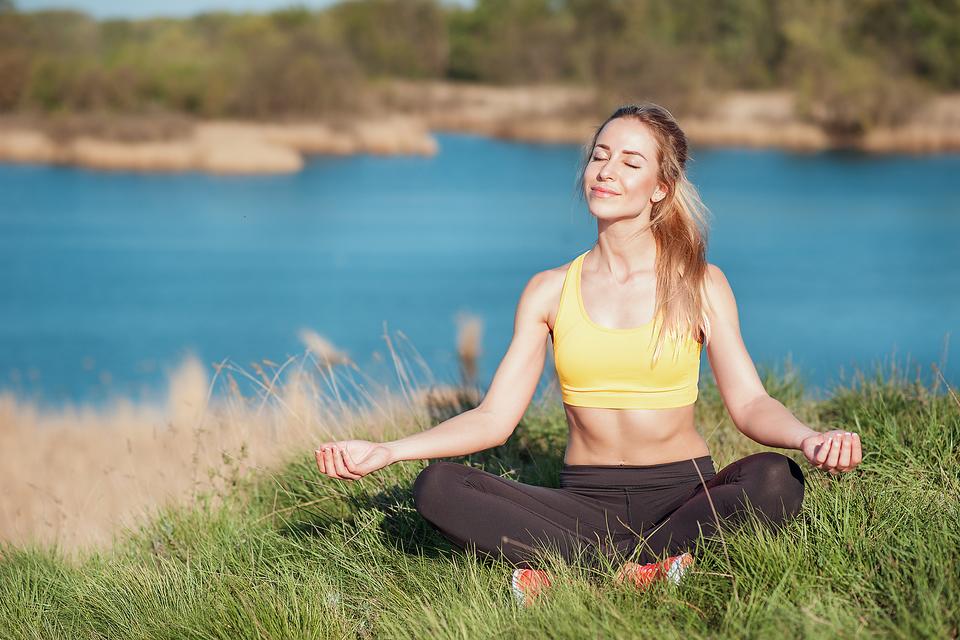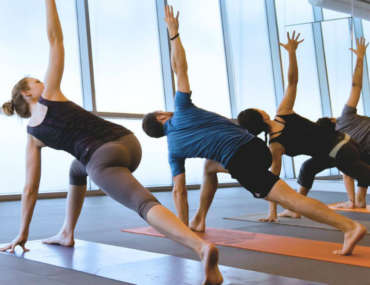The thyroid is a small gland in the neck that plays a crucial role in regulating metabolism, energy levels, and overall health. An imbalance in thyroid function can lead to various health issues such as weight fluctuations, fatigue, mood swings, and hormonal imbalances. Fortunately, yoga offers a holistic approach to improving thyroid health by stimulating the thyroid gland, reducing stress, and promoting balance in the endocrine system.
Whether you’re attending a Rishikesh yoga retreat or embarking on a yoga teacher training in Rishikesh, incorporating specific poses for thyroid health can enhance your experience.
In this Blog, we’ll explore 10 yoga poses specifically designed to improve thyroid function, increase energy, and enhance your overall well-being.
- Shoulder Stand (Sarvangasana)
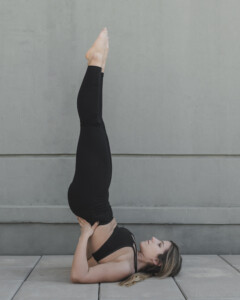
Practicing Shoulder Stand (Sarvangasana) for thyroid stimulation and improved metabolism in yoga.
The Shoulder Stand is one of the best poses to stimulate the thyroid gland, as it places pressure on the area around the neck.
How to Perform:
- Lie flat on your back.
- Lift your legs slowly, bringing them overhead.
- Support your lower back with your hands and rest on your shoulders, keeping your body aligned.
- Hold for 30 seconds to 1 minute, breathing deeply.
Benefits: This pose increases blood flow to the thyroid gland and helps balance thyroid hormone production. It is especially beneficial for hypothyroidism.
- Plow Pose (Halasana)

Plow Pose (Halasana) for thyroid stimulation and stress relief in yoga practice.
The Plow Pose complements the Shoulder Stand by continuing to apply pressure to the thyroid area and promoting circulation.
How to Perform:
- From the Shoulder Stand, gently lower your legs over your head until your toes touch the floor behind you.
- Keep your hands supporting your lower back or resting on the mat.
- Hold for 30 seconds to 1 minute, breathing slowly.
Benefits: Plow Pose helps improve digestion, relieves stress, and stimulates the thyroid gland to boost hormone regulation.
- Fish Pose (Matsyasana)

Fish Pose (Matsyasana) – Open your heart and stimulate your thyroid with this relaxing backbend.
Fish Pose is considered the counter-pose to the Shoulder Stand and Plow Pose, stretching the neck and stimulating the thyroid gland in the process.
How to Perform:
- Lie on your back with your legs extended.
- Lift your chest by arching your back and resting your crown on the floor.
- Place your hands under your hips or rest them alongside your body.
- Hold for 30 seconds, breathing deeply.
Benefits: This pose stretches the thyroid area, boosts circulation to the neck, and can help reduce neck stiffness while improving thyroid function.
- Cobra Pose (Bhujangasana)

Cobra Pose (Bhujangasana) for thyroid stimulation and spinal strength in yoga practice.
Cobra Pose not only strengthens the spine but also stimulates the throat, making it beneficial for thyroid health.
How to Perform:
- Lie face down on the floor with your hands under your shoulders.
- Slowly lift your chest, engaging your back muscles and opening your throat.
- Hold for 20 to 30 seconds, breathing deeply.
Benefits: Cobra Pose increases blood flow to the thyroid, stimulating the gland and helping regulate metabolism.
- Cat-Cow Pose (Marjaryasana-Bitilasana)
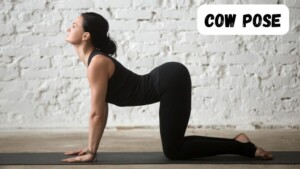
Cat-Cow Pose (Marjaryasana-Bitilasana) for improving neck mobility and promoting thyroid balance.
This dynamic flow between Cat and Cow Pose stretches and massages the neck, which can benefit the thyroid gland.
How to Perform:
- Begin on all fours with your hands under your shoulders and knees under your hips.
- On an inhale, arch your back (Cow Pose), lifting your head and tailbone toward the ceiling.
- On an exhale, round your spine (Cat Pose), tucking your chin to your chest.
- Repeat 10 to 15 times, moving with your breath.
Benefits: This gentle movement improves circulation, relieves tension in the neck, and supports thyroid health.
- Bow Pose (Dhanurasana)
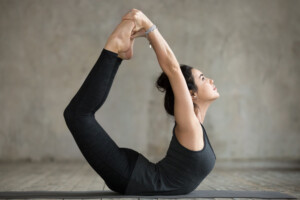
Bow Pose (Dhanurasana) for thyroid stimulation, chest opening, and posture improvement.
Bow Pose opens up the chest and throat, providing a deep stretch that stimulates the thyroid.
How to Perform:
- Lie on your stomach and bend your knees.
- Reach back to grab your ankles, lifting your chest and thighs off the floor as you pull.
- Hold for 20 to 30 seconds, breathing deeply.
Benefits: Bow Pose increases circulation in the thyroid area and promotes better hormone balance, while also relieving stress.
- Bridge Pose (Setu Bandhasana)
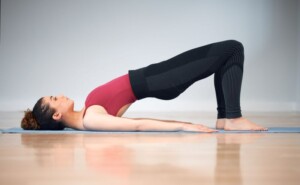
Bridge Pose (Setu Bandhasana) for thyroid stimulation and chest opening in yoga practice.
Bridge Pose is excellent for opening the chest and neck area, which can help stimulate thyroid function.
How to Perform:
- Lie on your back with your knees bent and feet hip-width apart.
- Press through your feet to lift your hips off the floor.
- Interlace your hands under your back and hold the pose for 30 seconds to 1 minute.
Benefits: This pose promotes blood flow to the thyroid gland and can improve thyroid hormone production.
- Legs Up the Wall Pose (Viparita Karani)
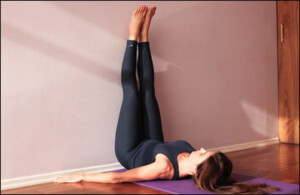
Legs Up the Wall Pose (Viparita Karani) for stress relief and thyroid balance in yoga practice.
This restorative pose helps relieve stress, which is a major contributor to thyroid imbalances.
How to Perform:
- Sit close to a wall and swing your legs up, resting them against the wall while your back is flat on the floor.
- Stay in the pose for 5 to 10 minutes, breathing deeply and relaxing.
Benefits: Legs Up the Wall helps calm the nervous system, reduce stress, and balance hormone levels, all of which contribute to thyroid health.
- Camel Pose (Ustrasana)
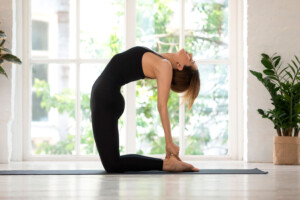
Camel Pose (Ustrasana) yoga pose to stimulate the thyroid and enhance spinal flexibility.
Camel Pose stretches the neck and throat, stimulating the thyroid gland and increasing circulation.
How to Perform:
- Kneel on the floor with your knees hip-width apart.
- Arch your back, reaching your hands toward your heels, while lifting your chest and head.
- Hold for 20 to 30 seconds, breathing deeply.
Benefits: Camel Pose stimulates the thyroid gland and helps regulate thyroid function, while also improving posture.
- Reclining Bound Angle Pose (Supta Baddha Konasana)
-

Reclining Bound Angle Pose (Supta Baddha Konasana) yoga pose for relaxation and thyroid health
This restorative pose helps reduce stress and stimulate the endocrine system, which includes the thyroid.
How to Perform:
- Lie on your back and bring the soles of your feet together, letting your knees fall open.
- Place your hands on your abdomen or by your sides, and relax in this position for 5 to 10 minutes.
Benefits: Reclining Bound Angle Pose promotes relaxation, calms the mind, and helps balance hormones by reducing stress.
Conclusion:
Incorporating these yoga poses into your daily routine can support thyroid function and improve your overall well-being. Along with regular practice, it’s essential to maintain a balanced diet, manage stress, and stay active. If you’re dealing with thyroid issues, consult with your healthcare provider before beginning a new exercise routine to ensure it’s right for you.


